
September 1999
Darwinian Call Centers
BY DENNIS COX, PIPKINS, INC.
Darwin would have felt at home in a modern call center. He would have been able to
study its constantly evolving nature and see his theories in practice.
Modern call centers are places of continuous change. The technology changes as new
ACDs, IVR and other CTI advancements become available. Call centers also often have a high
turnover of people, and new agents may be recruited for new or expanding services. Perhaps
most significantly, the workload changes - in volume, incidence and nature. Every day is
different from the last, next week will be different from this week and six months from
now...well, who knows? New services, increased opening hours and promotions all contribute
to evolutionary, and in some cases revolutionary, change.
How does the call center manager manage all this change? A plethora of tools are
available, most of which are technology-driven. Tools such as complex call routing
scripts, real-time displays, call analysis and agent monitoring offer the promise of
increased efficiency and customer satisfaction. But how does the manager allocate the
personnel to meet these constantly changing needs?
In a majority of cases, all or most agents in a call center work fixed shifts. They do
the same duty every week, often with the same start time and the same days off. Agents may
even go for their coffee and lunch at the same time. This custom has usually evolved from
a less demand-driven environment. Over time, the workforce has increased to meet an
increasing workload, but the placement of people to shifts is done on the basis of
covering either early or late shifts. This practice can work very satisfactorily in an
office environment, but in a call center it is less than optimal. Why is this so?
The Curse Of The PCA
Most call centers have quality of service targets the managers are asked to meet.
These targets are a means of measuring the service offered to customers. How easily and
quickly does the customer get through to an agent? How easily the customer gets through is
usually a hardware issue — is the service freely accessible? How quickly the
customer’s call is answered is usually measured by the percentage of calls answered
(PCA) within a specific time interval, termed the service objective (SO). For example, a
PCA80/20s target specifies that 80 percent of calls are answered in 20 seconds.
Typically, in a call center, the PCA target is in the range of 80 to 90 percent and the
SO is 15 to 30 seconds. If we look at an example of the relationship between the number of agents and the achieved PCA, the result would be as shown in Figure 1.
Using this graph, we can see that providing a PCA of 80 percent would require 17
agents. If the service was under-provided by two agents, the PCA would drop to 53 percent,
a decline of 27 percent. If the service were over-provided by two agents, the PCA would
only rise to 94 percent, an increase of 14 percent.
This demonstrates that the relationship between PCA and agent provision is nonlinear.
If the call center is understaffed for a period, the fall in the PCA cannot be recovered
by overstaffing by the same number for some other period. It is crucial that staffing be
configured as closely as possible to the requirement at all times. If it is not, then the
only way of meeting service targets is by overstaffing — and that costs money.
How Flexible Are You?
There are a number of areas where flexibility in working practices can bring
rewards. How many of these statements are true in your call center?
- My people go for breaks and lunches at the same times every day.
- My people go for breaks and lunches at the same times every week.
- My people start at the same time every day.
- My people start at the same time every week.
- My people work the same days of the week every week.
- My people work the same number of hours every day.
- My people work the same number of hours every week.
Why Be Flexible?
Consider this example: The following is based on a call center that is open from
8:00 a.m. to 6:00 p.m., Monday to Saturday. The agents work a 40-hour, five-day week.
There is a 30-minute lunch and two 15-minute breaks each day. The starting times of the
shift were initially fixed as being the same each day of the week. Schedules were then
produced to meet the forecasted demand. The rules were then changed to allow the starting
times for any shift to flex up to one hour within the week. Figures 2, 3 and 4 illustrate the fit of
agents to calls on Monday, Wednesday and Saturday. As can be seen, the fit of agents to
the requirements is much closer when the starting times of agents are allowed to be
different on different days during the week. The reason for this can be seen in Figure 5.
The incidence of calls is such that requirements vary from day to day. Not only does
the volume vary, but also the pattern of arrival changes from day to day. If starting
times are fixed over the week, it will restrict the accurate placement of people to meet
the changing demand. The same holds true for the allocation of breaks and lunches. The
ability to vary the lunchtime from one day to the next will increase the ability to meet
different incidence patterns of calls.
Now consider another aspect of call arrivals — the change in
distribution over time. Figure 6 shows the call incidence for two
Mondays, 13 weeks apart. The graph shows the pattern of call arrivals has changed over
time, even though the volume is very similar.
If agents’ schedules are fixed on a roster for a set period, then the fit of
agents to calls will be optimal only for the first week of the roster. After that date,
there is a high probability that call incidence will change. It may not
appear significant, but Figure 7 shows the increase in deviation
using fixed shifts. As we have seen earlier, a small loss of accuracy can have a large
effect on service. The ability to redefine shifts on a regular basis can help ensure
optimal staffing.
The purist’s viewpoint would be that since a call center is a constantly changing
environment, as much flexibility as possible should be introduced to allow the center to
continue to meet customer needs. This maxim should apply not just to personnel but to all
elements, including management.
In practice, a number of constraints will come into play, not the least of which is
agents’ morale. This should always be considered carefully before making changes to
working practices. Often the changes that occur in the short- to medium-term do not
necessitate full work flexibility for all staff. Most of the benefits described above
could be realized by introducing more flexible shifts for 10 to 20 percent of the
workforce. However, the possible benefits are quite tangible. Introducing flexible breaks,
start times and week-on-week changes could each improve the PCA by 1 to 2 percent. This
translates into 1 to 2 percent savings in personnel costs.
And that is worth thinking about.
Dennis Cox is the managing director of PIPKINS UK, Ltd., the European headquarters
for PIPKINS, Inc. Dennis worked for thirteen years as a workforce efficiency manager at BT
(formerly British Telecom) before coming to PIPKINS in 1992. One of his main areas of
expertise is the effective integration of workforce management tools and human resources.
PIPKINS is a supplier of workforce management systems and services to both United States
and international call centers. PIPKINS, Inc. is headquartered in St. Louis, Missouri,
with its European Headquarters located in Yorkshire, England.
Figure 1
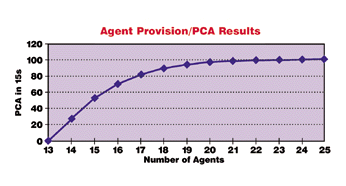
[return to text]
Figure 2
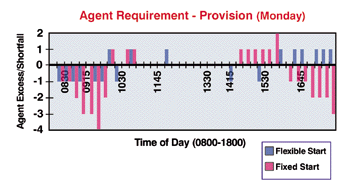
[return to text]
Figure 3
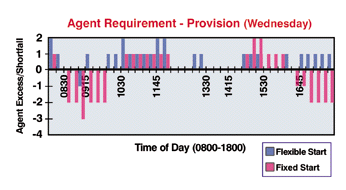
[return to text]
Figure 4
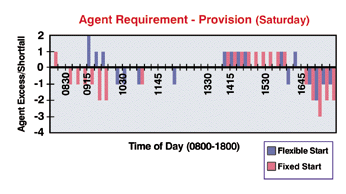
[return to text]
Figure 5
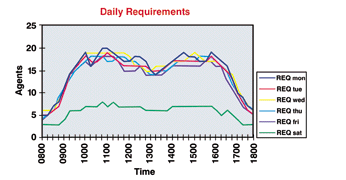
[return to text]
Figure 6
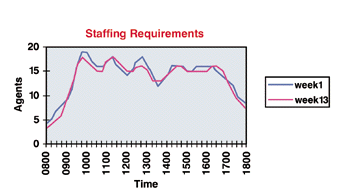
[return to text]
Figure 7
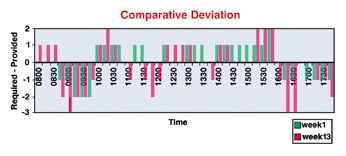
[return to text]
|